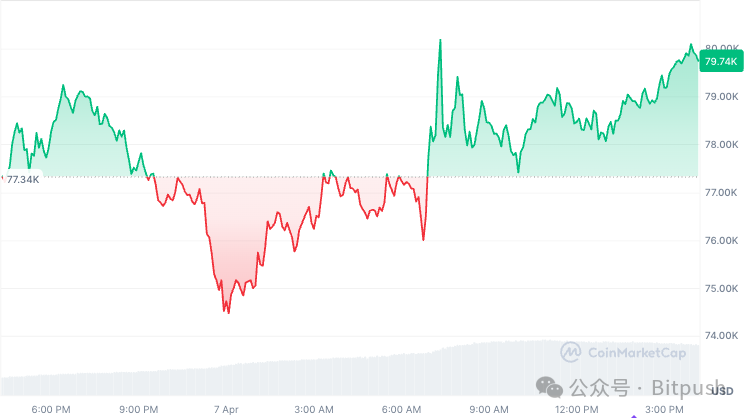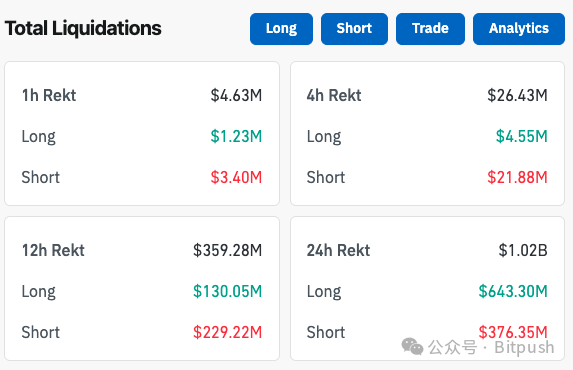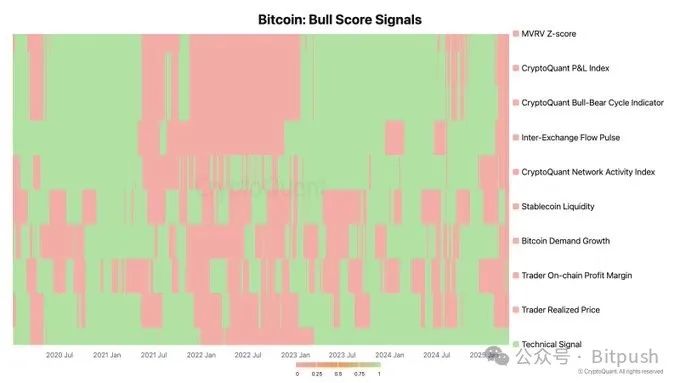The market hates uncertainty.
Written by: BitpushNews Mary Liu
In the past 24 hours, the market has fluctuated sharply due to news, with the details of Trump's tariff policy swinging back and forth—from rumors of a "90-day delay" to "debunking false news." Bitcoin experienced significant volatility, dropping to a low of $74,436 before rapidly rising to $81,200, with a daily fluctuation of up to 9%.
As of the time of writing, Bitcoin is holding at the key support level of $79,000, while Ethereum is struggling to recover after falling below $1,500, and XRP is reported at $1.92.

The derivatives market is heavily risk-averse, with the total open contracts across the network dropping 10% to $91.19 billion. Coinglass data shows that over the past 24 hours, the liquidation amount exceeded $1 billion, and Bitcoin's market cap share slightly increased to 62.6%.

Expert Opinions: What’s Next?
CryptoQuant's research director Julio Moreno believes:
"Buying the dip right now is like catching a falling knife! The situation for Bitcoin has not improved. There is only one bullish signal in the bull market score index."

Cosmo Jiang, a general partner at Pantera Capital, told Bloomberg:
"The current market trend is mainly driven by macro factors. The pullback triggered by the tariffs is a specific event-driven decline, rather than a deep-seated economic issue. Just as the tariff policy is a variable injected by humans, the Trump administration can withdraw these measures when it believes it has received sufficient concessions from other countries."
The latest report from Binance Research suggests that ongoing geopolitical and economic uncertainty may continue to dominate the market:
"The most aggressive tariffs since the 1930s are creating a ripple effect in the macro economy and cryptocurrency markets. In the short term, cryptocurrencies may still be volatile, and market sentiment will fluctuate with the ongoing trade war. If macro conditions stabilize, a new narrative takes hold, or cryptocurrencies re-establish their role as a long-term hedge, new growth may follow. Until then, the market may remain range-bound and react to macro news."
Stephen Wundke, director of strategy and revenue at Algoz, a quantitative digital asset investment firm, stated:
"For now, the market hates uncertainty, so we can expect trading to be more volatile in the coming weeks/months, and the next rally will be delayed (if it happens at all) — unless Trump makes another strong statement regarding the crypto industry. But what we can be sure of is that the messages currently coming from the White House have no certainty."
Charlie Sherry, financial director and cryptocurrency analyst at BTC Markets, mentioned in his market update:
"Bitcoin has recently lost the key support level of $79,000 to $80,000 that it successfully held for the past month. This support level marks the bottom of the range after the historical peak correction. The next key support level is around $72,000, which is the peak before the U.S. elections. A potential shift in Trump's stance or an emergency intervention by the Federal Reserve could be two factors that help Bitcoin's price rise above $80,000."
Bitcoin researcher Axel Adler Jr. pointed out:
Short-term forecasts indicate that Bitcoin's price will oscillate in the range of $81,600 to $88,700, with the key "maximum pain" level of $86,000 becoming an important benchmark for the April 11 options expiration. In the medium term, if macroeconomic uncertainty persists and expectations for Federal Reserve rate cuts rise, some traditional market funds may shift towards Bitcoin, providing support. However, caution is needed regarding the risk of sharp pullbacks due to overall investor risk aversion.
Greg di Prisco, co-founder of centralized stablecoin development company M^0 Labs, commented on the long-term impact of the Trump administration on cryptocurrencies, stating:
"Perhaps more important than Trump's direct actions is his influence on the legislative process, which is the most significant development for the industry. The stablecoin legislation being considered by state governments will put the U.S. in a favorable position in the competition."
Prisco shared his three major predictions for the crypto industry in 2025:
"I believe you will see the GENIUS Act become the legislation that the government ultimately agrees upon and passes, but this may happen in the second half of the year. 2. More traditional financial institutions will begin to launch tokenized products inspired by BlackRock's BUIDL success. 3. Stablecoins will continue to prove themselves as a killer use case for cryptocurrencies. They will start to integrate into mainstream fintech applications."
免责声明:本文章仅代表作者个人观点,不代表本平台的立场和观点。本文章仅供信息分享,不构成对任何人的任何投资建议。用户与作者之间的任何争议,与本平台无关。如网页中刊载的文章或图片涉及侵权,请提供相关的权利证明和身份证明发送邮件到support@aicoin.com,本平台相关工作人员将会进行核查。




